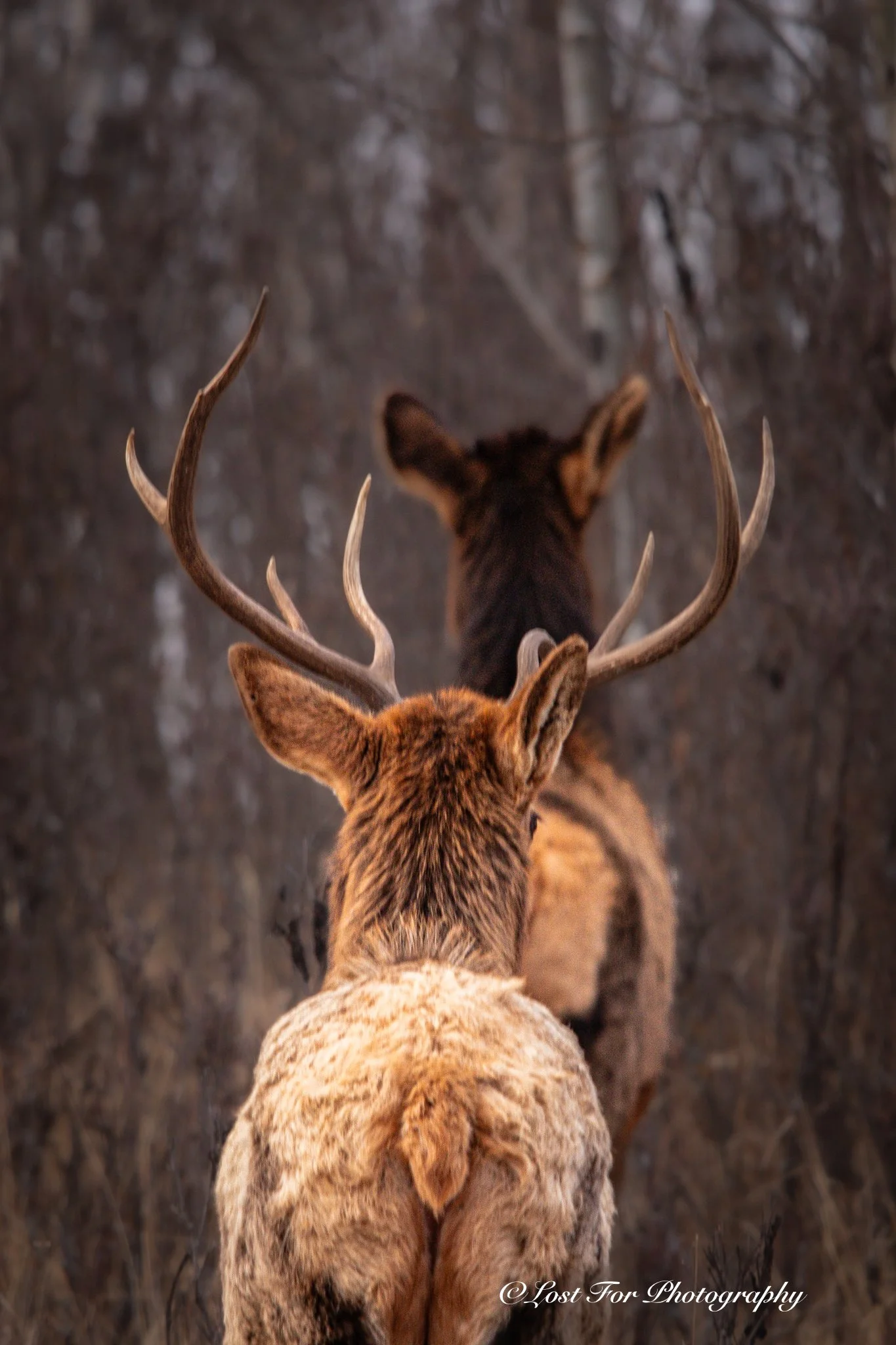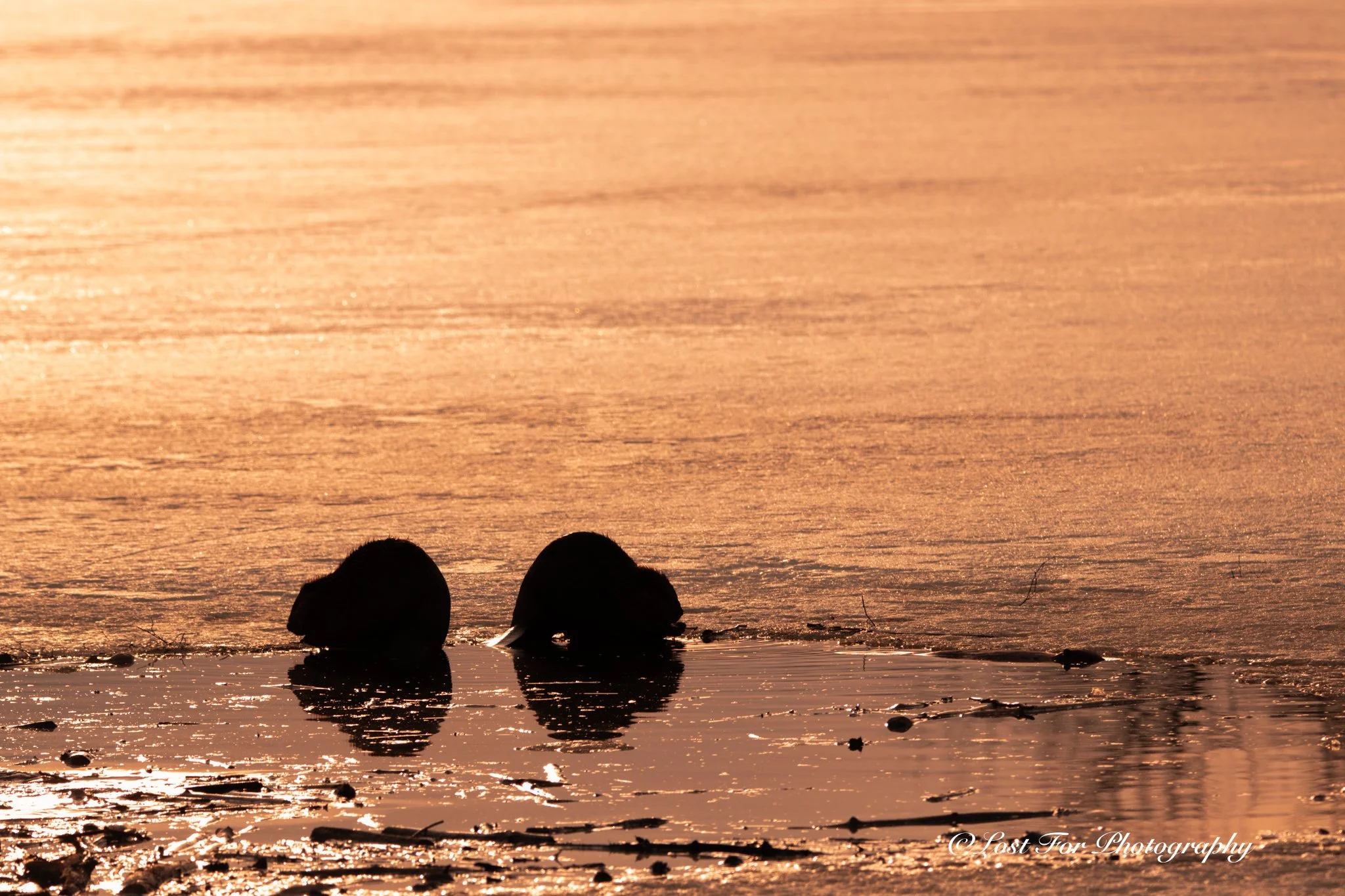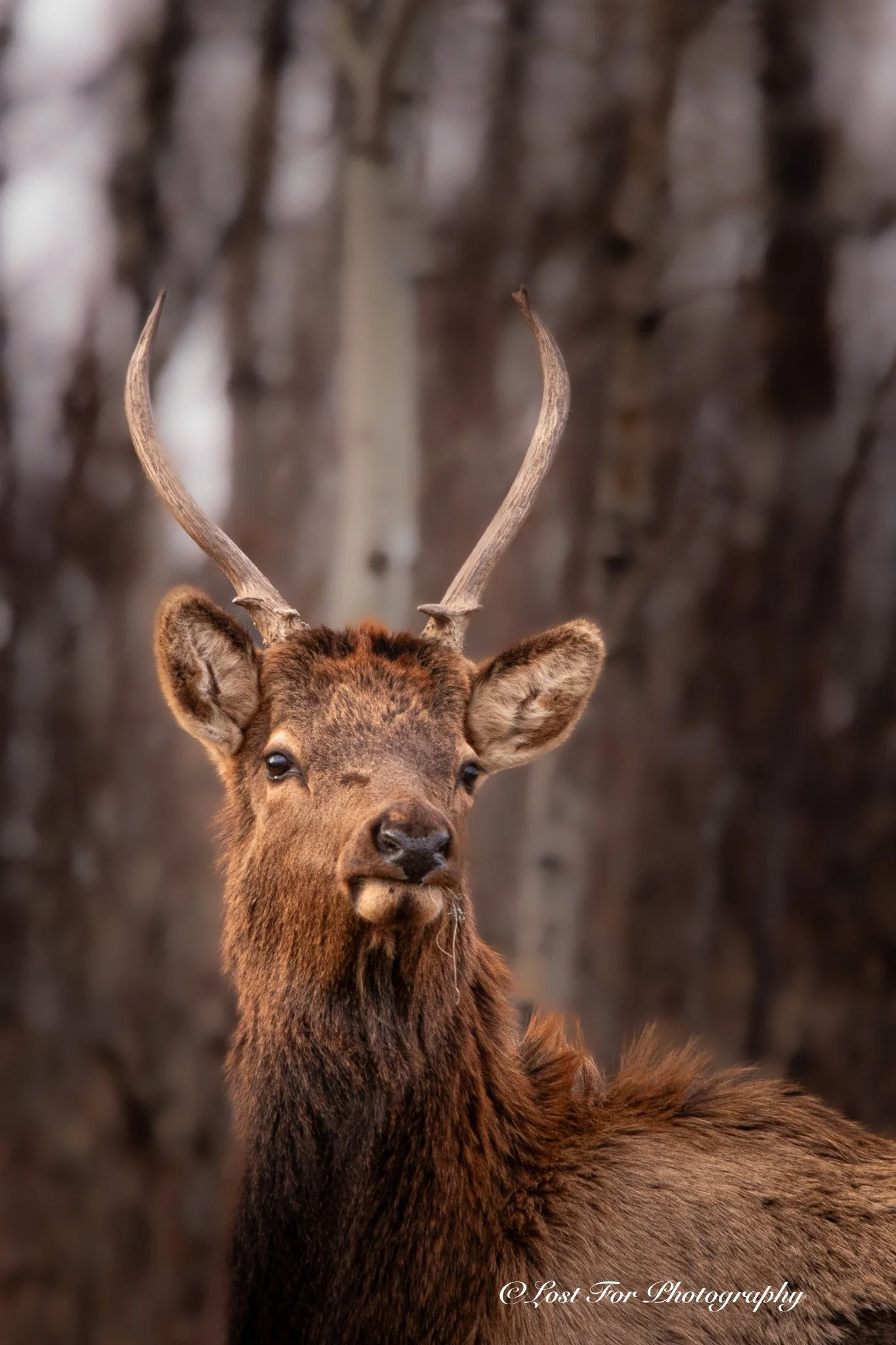Wildlife Part 5 - Paige Talks Elk
Good Morning everyone,
This week I have an addition to the wildlife series that is a project of mine with a few other wildlife photographers. This week, I’ll be the one talking about Elk and the beauty of these wonderful animals. Earlier this week I had a chance to encounter some wild Elk at a local National Park called Elk Island National Park. It is all in the name. This park is just about an hour east outside of Edmonton, Alberta, Canada and it is one I frequent alot due to its wonderful wildlife, great hiking trails, and overall beauty of the park. Parks Canada does a wonderful job keeping this park welcoming for all visitors and more importantly, they look out for the wildlife. With all the times I visit this park, I never encountered the herd of Elk that resides in it until now. Let me tell you the story.
Title: Framing His Girl
Taken: March 25, 2025
Location: Elk Island National Park, Alberta, Canada
Photographer: Paige Brenneis - Lost For Photography
March 25, 2025
On March 25, 2025, my mum and I took a day long road trip around Alberta, embracing the beautiful Spring day, celebrating new beginnings, and enjoying the company of each other. We played with the light of the day as it passed over the sky from east to west, even with the high noon bright sun the light was plentiful. Now as we made our way home, we passed through Elk Island National Park but were not sure we would even get anything due to how low the sun has become in the sky. It was around 6pm, maybe 7pm the latest, and the park was becoming engrossed in shadows. You either had to capture the light facing east, hike into the park in the slushy, sopping, soggy trails, or go for silhouettes. We stayed on the main road due to the lateness of the day, my dog being in the back of the truck, and just how wet the ground would be. There was not enough time to hike trails unless you had a flashlight along with you and good ol’ pair of rubber boots. I did not have rubber boots, not even winter boots, but only my Ariat Sport Rambler Cowboy boots on. As we made our way slowly along the main road that passes through the park, we did not expect to come across the wildlife that we did see. Well not at least as much of the wildlife that we came across. First we came across this pond to the west where there were three beavers busy in the evening light. Now since they were facing west, getting a great shot with light in their eyes was going to be impossible. Knowing I was facing against the light, a silhouette shot was going to be my only best shot. I got low, down to the ground, 150-600mm Sigma on, and I observed the beauty of the three beavers together. It was peaceful, tranquil, and a moment I won’t ever forget. I felt at one with the beavers and the nature around me, with the sound of birds in the trees, a slight breeze, and just quiet.
Title: Dinner Together In Spring
Taken: March 25, 2025
Location: Elk Island National Park
Photographer: Paige Brenneis - Lost For Photoraphy
After a few moments had passed, we hopped back into the truck and continued on our way. Now the beavers were not the only thing we saw. We came across our regular viewing of Canada Geese, the one or two Plains Bison along the road, a crow, and later on a Great Grey Owl, but as we were about half way through the park, we came across some Elk. At first they were to the East of us, just a little off the road but quickly bolted into the safety of the trees as we stopped to view them. We were at the time a little disappointed we could not get a shot at the time of them but little did we know that a chance was still coming. As we moved along around the corner, I noticed that a car was stopped on the side of the road. A tell tale sign that there was something up ahead worth stopping for. As we crept around the corner, we came across the herd of Elk and these ones were not so quick to move away from us. From what were were able to observe, there was at least 2 Male Elk in this grouping. One with almost a full rack of horns and one where his horns were just starting to form. We rolled to a stop, quietly turned off the engine, rolled down the windows. When we go out, we made sure that it was when the Elk were now far enough away at a safe distance and we didn’t leave from behind the vehicle if we did get out. Now I was in the passenger seat and this herd with the 2 males were off to the west. I didn’t have to get out but only had to roll down my window. They were so calm, so quiet, but I know for sure that they were on high alert. The males didn’t take their eyes off of us as the herd silently moved forward and into the trees. Once the last female was safely in the trees, that is when the 2 males finally joined them, disappearing into the grass and wooded areas. There was no threat being given from the herd or from us. It was a small moment where it felt like we all understood each other but also being very cautious and aware of each other’s movements.
Title: Gentleman In Black
Taken: March 25, 2025
Location: Elk Island National Park
Photographer: Paige Brenneis - Lost For Photography
This one male though, he was definitely being protective of this one female. Wherever she went, he was close behind and he made sure that he stood between her and us, occasionally looking back making sure we were not following. I shared the one image earlier of this beautiful male standing directly behind this female, his horns perfectly framing her. It was a very picturesque moment and I didn’t miss a beat to capture it.
Title: Framed
Taken: March 25, 2025
Location: Elk Island National Park
Photographer: Paige Brenneis - Lost For Photography
Now this male shown above was my favorite out of my collection of photographs that I captured. Before I share my all time favorite version of this beautiful gentleman, I want to share some fun facts about the Elk in Elk Island National Park.
Fun Facts of The Elk In Elk Island National Park
Elk Island National Park is home primarily to two species of elk: the Rocky Mountain elk and the Plains elk. The Rocky Mountain elk is known for its impressive antlers and can typically be found in the western regions of Canada and the United States, while the Plains elk is more adapted to the open grasslands and is generally found in the central and eastern parts of North America.
In Elk Island National Park, these elk populations thrive in the park's diverse habitats, which include grasslands, wetlands, and forests. The park plays a crucial role in conserving these species, as it provides a safe haven free from predators and human encroachment. Visitors to the park can often see these majestic animals during early morning or late evening, making for a wonderful wildlife photography opportunity.
Fun Facts About Plains Elk
Scientific Name: The Plains Elk is scientifically known as Cervus canadensis, which highlights its Canadian roots.
Size Matters: Adult males, known as bulls, can weigh between 500 to 1,100 pounds, while females, or cows, typically weigh 400 to 600 pounds. Bulls are significantly larger, especially during the rutting season.
Distinct Antlers: Male Plains Elk grow impressive antlers that can reach up to four feet in length and weigh as much as 40 pounds. They shed their antlers each year, usually in late winter to early spring.
Vocalization: Elk are known for their unique vocalizations, particularly the high-pitched bugle that males produce during mating season. This call can be heard over long distances and is used to attract females and establish dominance among competing males.
Social Animals: Plains Elk are social creatures that usually live in herds. During the summer, these herds can contain dozens to even hundreds of individuals, while in winter, they may split into smaller groups.
Grazers and Browsers: While often seen grazing on grasses, they also consume a variety of other vegetation, including shrubs, leaves, and bark. This diverse diet allows them to thrive in various habitats.
Habitat Range: Although Plains Elk primarily inhabit grasslands and open forests, they are incredibly adaptable and can be found in a range of environments from prairies to mountainous areas.
Migration Patterns: Some populations of Plains Elk are known to migrate seasonally, travelling to lower elevations during winter months to escape deep snow and find food.
Lifespan: In the wild, Plains Elk can live up to 10 to 15 years, though some individuals may survive longer in protected areas or national parks.
Role in Ecosystem: As a key species in their habitats, Plains Elk play a vital role in maintaining ecological balance. Their grazing habits contribute to plant diversity and help shape the landscape.
These incredible animals are not only a sight to behold but also an essential part of the Canadian wilderness, showcasing the beauty and complexity of our natural world.
Title: Pronghorned Elk Gentleman (not actually pronghorned, just his horns were only starting to take form)
Taken: March 25, 2025
Location: Elk Island National Park
Photographer: Paige Brenneis - Lost For Photography
Fun Facts About Rocky Mountain Elk
Scientific Name: The Rocky Mountain elk is scientifically known as Cervus canadensis.
Size: Adult males, also called bulls, can weigh between 300 to 1,100 pounds, whereas females, or cows, typically weigh between 450 to 600 pounds.
Antlers: Bulls grow impressive antlers that can span up to four feet in length. These antlers are shed annually and regrow each year.
Vocalizations: During mating season, bulls are known for their distinctive bugle calls, which carry for miles and are often used to attract females.
Diet: Rocky Mountain elk are herbivores, primarily grazing on grasses, shrubs, and the bark of trees, depending on the season.
Habitat: They thrive in diverse habitats including forests, meadows, and mountainous regions, often migrating to lower elevations during winter for food.
Social Structure: Elk are social animals that typically form herds. These herds can range from a handful of individuals to several hundred during the winter months.
Lifespan: In the wild, Rocky Mountain elk can live up to 10-12 years, but some can survive longer in protected environments.
Adaptations: Their large bodies and long legs allow them to navigate rugged terrains, while their keen sense of hearing and smell help them detect predators like wolves and cougars.
Cultural Significance: Rocky Mountain elk hold a special place in Indigenous cultures and have been an important source of sustenance and materials for many communities throughout history.
Understanding these fascinating creatures adds to the appreciation of Alberta’s stunning landscapes where they roam freely!
Elk are culturally significant in Indigenous cultures across North America, symbolizing strength and resilience. Revered for their meat, they provide sustenance and illustrate the deep connection Indigenous peoples have with nature. Elk appear in stories and teachings, symbolizing courage and community. Their antlers are used in ceremonies, representing beauty and the cycle of life. Overall, elk embody the relationship between Indigenous peoples and the natural world.
From a more personal perspective, encountering an elk in nature might suggest that you need to reconnect with your inner strength or take a moment to appreciate the natural world around you. It can be a gentle reminder to slow down, observe, and find balance in your life. In essence, seeing an elk is an invitation to acknowledge your own potential, embrace community, and respect the world we share.
I felt like I reconnected with my inner self when I observed the herd of Elk we came across. I felt calm with myself, at peace, and just living in the moment. Time had slowed down around me and just for that moment, it was just me, my camera, and the herd. It wasn’t until the door to the truck opening did I come back to the here and now and when I did, I had a new sense of calm. This is just a reminder, slow down in your life and enjoy the moment. It may get hectic at times but just come back to this moment inside, breathe, and let time slow down just a little bit. Now as I bid you all adieu, I will share with you my favorite photograph of the Bull Elk that I was observing. I call this Masculine Male.
Title: Masculine Male
Taken: March 25, 2025
Location: Elk Island National Park
Photographer: Paige Brenneis - Lost For Photography
Do not forget to register for my newsletter where you’ll be up to date with the latest news, projects of mine, some contests I hold, and all the new deals in my shop. Register below and become a reader along this roadtrip through life.






